|
 |
|
 |
|
|
It was the serpent – nahash in the
Hebrew Bible -- that tempted Eve to eat
fruit from the forbidden tree of knowledge
in the Garden of Eden, thus bringing about
the fall of humanity. The serpent was
then cursed and destined to be the most
despised beast on earth.
This conflict between man and slithering
snake is a metaphor of the conflict between
divine knowledge and the force of evil.
When Moses was appointed leader of the
Israelites, he was given the power to
control the serpent. In Numbers 21 we
learn that Moses made a serpent of bronze
and put it on a pole. Whenever a
serpent bit someone (and that happened
occasionally during their wilderness
sojourn), that person would look at the
serpent of bronze and live. |
|
|
|
There are four poisonous snakes mentioned in
the Hebrew Bible that are with us in Israel
to this day. But not to worry, in all
my years of hiking, particularly in the
wilderness areas, I have seen not even one!
But I have often been asked, "Are there
poisonous snakes in Israel?" So here
goes a description… |
|
|
|
The black desert cobra or Egyptian
cobra, called peten shchor in
Hebrew, is found in desert areas from Egypt
on all the way to Iran. In Israel it
is found in the Judean Desert, the Arava and
the Negev. With a maximum length of
1.20 meters, the black desert cobra is
sometimes translated as asp. To
compensate for its weak vision, it has a
strong sense of smell which it uses to hunt
its prey.
The Egyptian cobra has a round body and a
narrow head. When the cobra finds its
prey -- birds, lizards, rats or other snakes
-- it grasps the prey for a long time, while
injecting its poison. It lets go of
the prey only after it is dead and then
devours its victim s-l-o-w-l-y. (Yum
yum!!) |
|
|
|
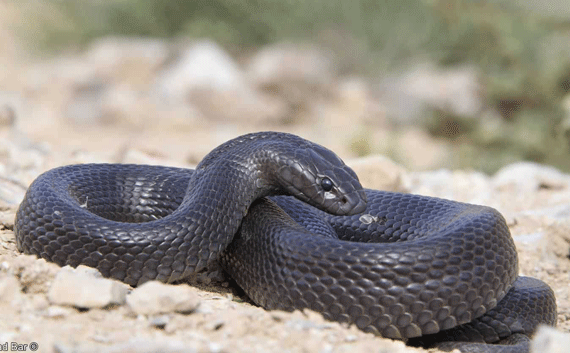 |
|
Courtesy of
Wikipedia Commons |
|
Black Desert Cobra or
Waterinnesia aegyptia or Peten Shchor |
|
|
|
The black desert cobra is connected in
scripture to the ancient craft of snake
charming. In a description of the
wicked, the psalmist (58: 4-5) sings "Their
poison is like the serpent (nahash).
They are like the deaf cobra (peten)
that stops its ear which will not heed the
voice of charmers, charming ever so
skillfully."
|
|
|
|
 |
|
Courtesy of
Wikipedia Commons |
|
Black Desert Cobra
mentioned in Isaiah 11 |
|
|
|
But in Isaiah's vision of the idyllic reign
of Jesse's offspring when the wolf shall
dwell with the lamb, "the nursing child
shall play by the cobra's (peten)
hole. (Isaiah 11:8) |
|
|
|
The carpet viper or ef'eh in
Hebrew changes color according to region
with its color ranging from grey-brown to
orange-red. Its back can be yellow to
reddish brown with lighter spots whose
borders are black. Near Eilat in the
south of Israel, some red-brown and purple
carpet vipers have been spotted. |
|
|
|
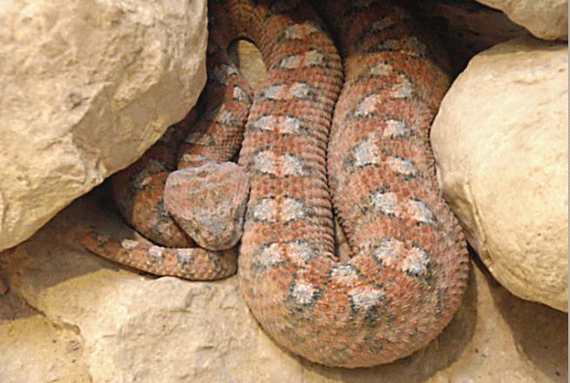 |
|
Courtesy of
Migron at Wikipedia Commons |
|
Poisonous Carpet Viper or
Ef'eh found between or under rocks |
|
|
|
They are found in all rocky regions like the
Gilboa mountains, the Jordan valley, the
Negev and En Gedi. They hide during the day
between the rocks and emerge in the cooler
evenings. Their maximum length is one
meter. |
|
|
|
The carpet viper eats small rodents,
lizards, crabs and insects. In some
populated areas they have become accustomed
to eating green toads which congregate in
puddles, irrigation drips and sewerage
streams.
|
|
|
|
The prophet Isaiah compares the carpet viper
to those who are separated from the Almighty
– that "he who eats of their eggs dies and
from that which is crushed a viper breaks
out." (Isaiah 59:5) |
|
|
|
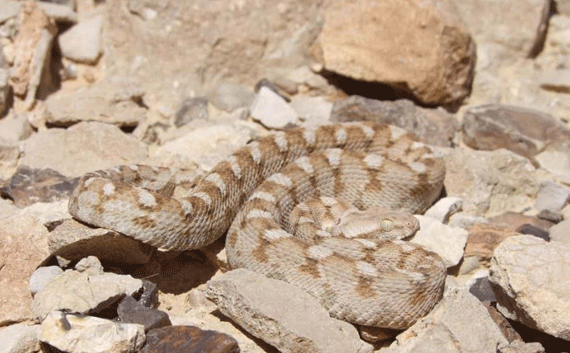 |
|
Courtesy of
Migron at Wikipedia Commons |
|
The carpet viper (Echis
coloratus in Latin) is mentioned in
Isaiah and in Job |
|
|
|
The prophet Job mentions both the peten
(cobra) and ef'eh (viper) in one
breath. In Job 20:16 the wicked
man "will suck the poison of cobras and the
viper's tongue will slay him." Oh my!!
Let's not be wicked! |
|
|
|
The Palestinian viper, named tzefa
in the Bible and Vipera Palaestinae
in Latin, is the most common poisonous snake
found in Israel. It has a triangular
shaped head because of its large prominent
poisonous glands on each side. It is
found in northern and central Israel.
In populated areas during hot weather, it
enters homes to hide in cool shady places.
The Palestinian viper is active at night. |
|
|
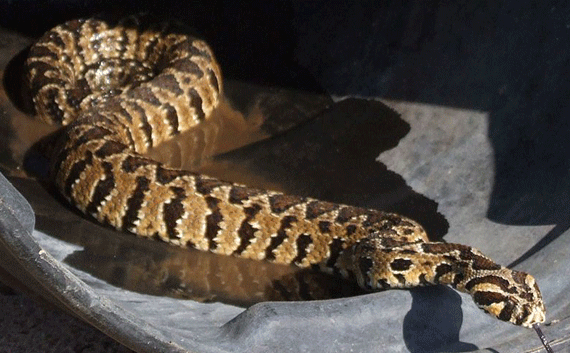 |
|
Courtesy of
Eren Finkle at Wikipedia Commons |
|
The Palestinian viper is
the most common poisonous snake found in
Israel |
|
|
|
Its maximum length is 1.35 meters. It
has a relatively wide body with a short
tail. It's body is yellowish with
brownish fragmented wavy zigzag stripes.
(My good friend Miriam who found one on her
porch described the background color as a
bright mustard yellow.) If the
markings on the back of the snake are
connected together, then the snake is a
poisonous tsefa.
|
|
|
|
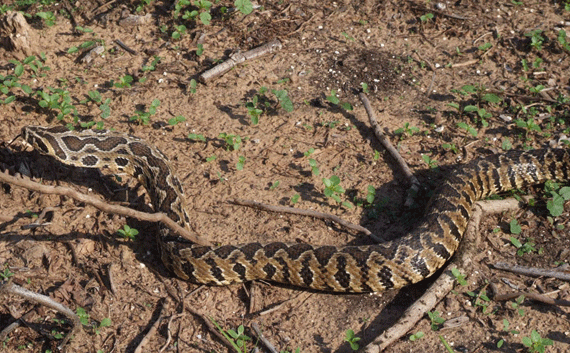 |
|
Courtesy of
Eren Finkle at Wikipedia Commons |
|
The Palestinian viper has
dark brownish wavy zigzag stripes on its
yellowish body |
|
|
|
I've heard that it's not aggressive but
don't ever try holding it. Even when held in
the accepted manner, it can manage to bite
the holder by extending one of its venom
teeth sideways and lashing its head rapidly
sideways and backwards.
|
|
|
|
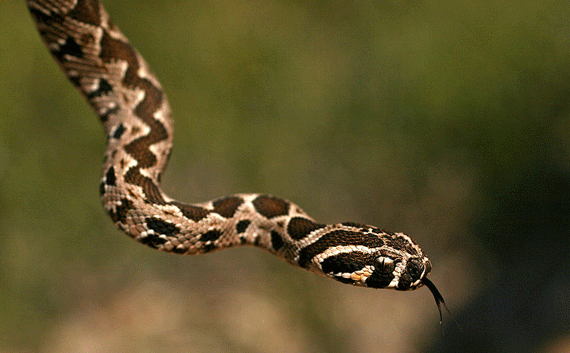 |
|
Courtesy of
Guy Haimowitz at Wikipedia Commons |
|
Isaiah referred to the
Palestinian viper in his prophecy against
the Philistines |
|
|
|
Isaiah used images of three different kinds
of snakes when he prophesized against the
Philistines. "Do not rejoice, all you
Philistines, that the rod that struck you is
broken, from the root of that snake will
spring up a viper (tzefa). Its
fruit will be a darting, venomous serpent."
Isaiah 14:29 |
|
|
|
The shefifon or Persian horned
viper buries itself in the southern
desert areas, coiled in loose sands.
It is so covered in sand that often only its
eyes protrude marked by two scaly little
horns above the eyes. It is light
yellow with brownish grey faded cross
stripes. Its maximum length is only 80
centimeters. Its Latin name is
Pseudocerastes persicus.
|
|
|
|
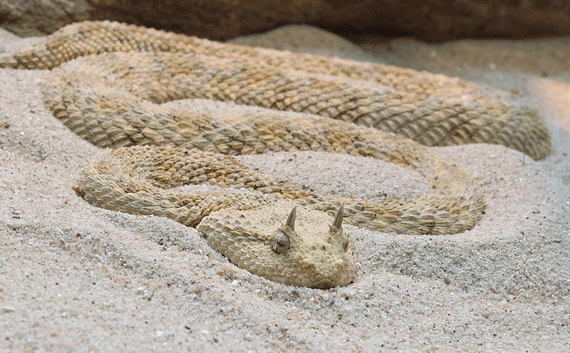 |
|
Courtesy of
Wikipedia Commons |
|
The Persian horned viper
buries itself coiled in loose sands in
desert areas |
|
|
|
The tribe of Dan is compared to this hidden
viper. "Dan shall be a serpent (nahash)
by the way, a viper by the path (shefifon)
that bites the horse's heels so that its
rider shall fall backward." (Genesis
49:17) |
|
|
|
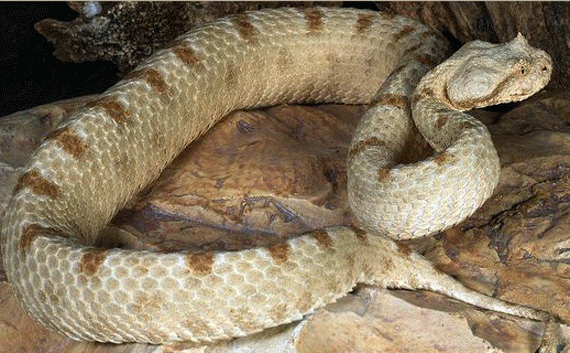 |
|
Courtesy of
Wikipedia Commons |
|
The tribe of Dan. lying in
ambush, is compared to the Persian horned
viper |
|
|
|
The horned viper lies in wait for its prey
under a bush or in the sand. Jacob's
prophecy about Dan may relate to its
location along the dangerously vulnerable
border with the Philistines or perhaps to
the tribe's strategic position close to the
main trade routes. Recently while
researching Samson, I read that perhaps this
verse compares Samson, a son of the tribe of
Dan, to the horned viper – both attacked
their adversaries alone. |
|
|
So the serpent and viper are portrayed as
threatening symbols of venom, evil and
temptation. Yet in one instance, in
Matthew 10:16 Jesus uses the image of the
snake in a somewhat positive way. "I am
sending you out like sheep among wolves.
Therefore be as shrewd as snakes and as
innocent as doves." Here we are back
to the image of the snake in the Garden of
Eden. "Now the serpent was more
cunning than any beast of the field which
the Lord God had made." (Genesis 3:1)
|
|
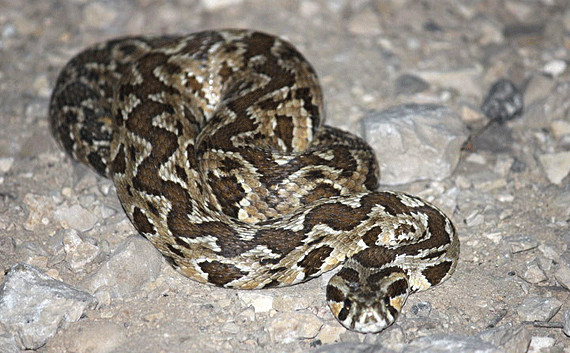 |
|
Courtesy of
Adam Matan in Wikipedia Commons |
|
Serpent and viper are
threatening symbols of venom, evil and
temptation |
|
|
|
Whether it's snake, serpent, viper, cobra or
asp, fear not. You won't see any of
these on your holy land pilgrimage.
(Unless that is, you go to visit my friend
Miriam! See below) Instead, you
will see donkeys, goats, sheep, rock hyrax,
camels, ibex, storks, ravens and gazelles.
As you travel along the holy land highways
and byways, you will constantly praise the
sovereign Lord Almighty for his wondrous
creations. |
|
|
|
Copyright 2019 Gila Yudkin. Permission
needed for any reuse. |
|
|
|
Read about the
balsam of En Gedi,
a popular antidote to snake bites in
biblical days. It may have been the
biblical Balm of Gilead which healed the
body and the soul.... |
|
|
|
Gila
Yudkin who calls herself a
Connecticut-born Yankee living in King
David's court, has not yet seen a poisonous
holy land snake. Even though she has
been guiding for nearly forty years!
She did however see a snake while in the
Sistine Chapel on a recent visit to the
Vatican in Rome. She gasped when she
realized that Michelangelo had painted the
serpent coiled around the tree of knowledge
in the Garden of Eden with the head of a
woman!! |
|
|
|
Although Gila has never seen a poisonous
holy land snake, her good friend Miriam
just last month faced a Palestinian viper.
During an outrageous heat wave, the viper
was coiled around a large clay pot on her
porch in a Jerusalem suburb! But not
to worry. She called a professional snake
catcher who arrived within twenty minutes! |
|
|
|
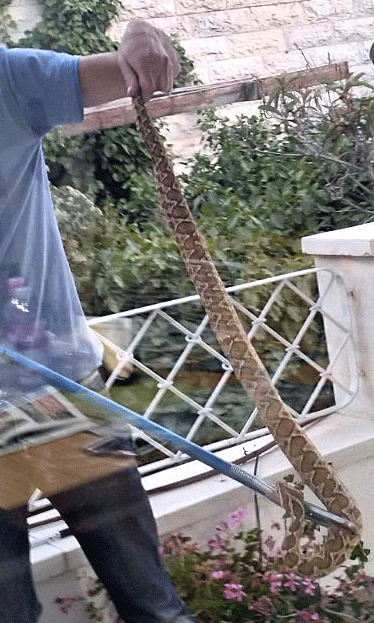 |
|
Photo:
Miriam Feinberg Vamosh |
|
A swinging 21st century
poisonous biblical snake just outside
Jerusalem |
|
|
|
Postscript: In response to Gila's
highlight on holy land venomous snakes,
Sonja Stroud from Ramsgate Kwazulu Natal,
South Africa wrote to her, |
|
|
|
"It is no wonder that Jesus used the image
of vipers to describe the sliminess of
Pharisees and Sadduces in Matthew 3:7, "But
when he saw many of the Pharisees and
Sadduces coming to his baptism, he said to
them, 'You brood of vipers, who warned
you to flee from the wrath to come?' " |
|
|
|
"Let's
not get bitten by poisonous biblical snakes" (as text
without the photos) is one in a series of
free quarterly e-letters sent on request to
tour leaders, pastors, clergy, teachers,
Bible students, colleagues and friends.
If you'd like to receive "Holy Sites: Gila's
Highlights" or to respond to a web
article, please
contact
Gila. |
|
|
|
 |
|
Photo:
Gila Yudkin |
|
Gila with snake charmer
and holding a cobra in Delhi, India |
|
|

